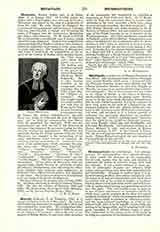

Metastasio, PIETRO, Italian poet, b. at Rome,1698; d. at Vienna, 1782. Of humble origin, his father, once a Papal soldier, was later a pork-butcher; Metastasio was placed in the shop of a goldsmith to learn his craft. By some chance he attracted the attention of the juris consult and litterateur, Vincenzo Gravina, who took him in charge, and Graecizing his name of Trapassi, into the synonymous Metastasio, gave him a solid education. At his death in 1718 he left to his protege a considerable sum of money, which the latter soon dissipated. Then he was compelled to apprentice himself at Naples to a lawyer, who, however, found the apprentice more prone to write verses than to study legal codes. The beginning of Metastasio’s real career is marked by the composition, at the request of the Viceroy of Naples, of his musical drama, the “Orti Esperidi”, which had signal success. The leading part therein was played by the famous actress, la Romanina(Marianna Benti-Bulgarelli). She at once became attached to the young poet, commissioned him to write a new play, the “Didone ab-bandona”, had him taught music by a noted teacher, and took him to Rome and to Venice with her on her professional tours. At Vienna the Italian melodramatist, Apostolo Zeno, was about to relinquish his post as imperial poet, and in 1730 he recommended that Metastasio be appointed his successor. With this recommendation and with the aid of the Countess of Althann, who remained his patroness during her lifetime, he obtained the appointment. Thereafter, and especially during the decade between 1730 and 1740, Metastasio was engaged in the composition of his many melodramas (over seventy in number), his oratorios, cantate, canzonette, etc. Among the most noted of his melodramas—which announce the coming opera—are: “Endimione”, “Orti Esperidi”, “Galatea”, “Angelica”, “Didone”, “Siroe”, “Catone”, “Artaserse”, “Adriano”, “Demetrio”, “Issipile”, “Demofoonte”, “Clemenza di Tito”, “Semiramide”, “Olimpiade”, “Temistocle”, and his “Attilio Regolo”. The last-named is regarded as his masterpiece. All the pieces of Metastasio took the popular fancy, chiefly because he sedulously avoided all unhappy denouements, and, enlivening his efficacious dialogue with common sense aphorisms, he combined them with arias and ariettas that appealed to the many. His Letters are important in connection with any study of his artistic development.
The best edition of his works is that of Paris, 1780-82. Additions are found in the Opere Postume, Vienna, 1795. (See also the editions of Florence, 1820 and 1826). His letters were edited by Carducci (Bologna, 1883), and by Antona Traversi (Rome, 1886.)
J. M. D. FORD

